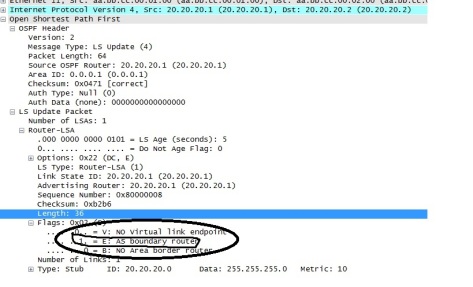Why do we need LSA4? Who generates it? Does it get generated with in Area 0? Do you always need LSA4? Can you reach the external network without LSA4?
what happens if we have NSSA and what if it doesn’t generate any LSA7 ? Do we still have LSA4?
Here are the answers..
My first scenario would be the following:
As you can see IOU1 and IOU2 are in AREA 1 and IOU2 and IOU3 are in AREA 0 and I am redistributing only Loopback1 in IOU1 instead of redistributing all the connected interfaces.

Configurations :
I have configured the OSPF process and the area in the interfaces.
IOU1:
router ospf 1
redistribute connected subnets route-map test
IOU1#show run int lo 1
Building configuration…
Current configuration : 61 bytes
!
interface Loopback1
ip address 1.1.1.1 255.255.255.0
end
IOU1#show route-map test
route-map test, permit, sequence 10
Match clauses:
ip address prefix-lists: test
Set clauses:
Policy routing matches: 0 packets, 0 bytes
IOU1#show ip prefix-list test
ip prefix-list test: 1 entries
seq 5 permit 1.1.1.0/24
IOU1#show run int ethernet 0/0
interface Ethernet0/0
ip address 20.20.20.1 255.255.255.0
ip ospf 1 area 1
end
IOU2:
show run int ethernet 0/0
interface Ethernet0/0
ip address 20.20.20.2 255.255.255.0
ip ospf 1 area 1
end
show run int ethernet 0/1
interface Ethernet0/1
ip address 10.10.10.1 255.255.255.0
ip ospf 1 area 0
end
As you can see IOU 1 is generating LSA 5 and you can see those LSA’s in IOU2 as well as IOU3
IOU1#show ip ospf database | B External
Type-5 AS External Link States
Link ID ADV Router Age Seq# Checksum Tag
1.1.1.0 20.20.20.1 1517 0x80000002 0x00D985 0
IOU2#show ip ospf database | B External
Type-5 AS External Link States
Link ID ADV Router Age Seq# Checksum Tag
1.1.1.0 20.20.20.1 1680 0x80000002 0x00D985 0
IOU3#show ip ospf database | B External
Type-5 AS External Link States
Link ID ADV Router Age Seq# Checksum Tag
1.1.1.0 20.20.20.1 1720 0x80000002 0x00D985 0
Now how will IOU2 and IOU3 know how to reach the ASBR and who is the ASBR? Here it is.
Since IOU1 redistributed a Loopback, it is the ASBR and thus it generated LSA5 . Hence when it sends the ROUTER LSA , the LSA type 1 it sets the E bit and sends indicating external capability that the advertising router is a ASBR hence by virtue of that IOU2 will come to know that IOU1 is the ASBR .
And here is the packet capture snippet of router LSA1 send by IOU1.

As you can see that when IOU1 (20.20.20.1) sends the router LSA it sets the E bit and sends which indicates that it is the ASBR .
There we go, we got the answer on how IOU2 can reach the external prefix ?
since the router IOU2 sees that IOU1 is the ASBR through Router LSA it doesn’t need LSA type4 to reach the external prefix.
We can clearly see the ospf database that there is no summary ASBR for area 1.
It is only for AREA 0.
IOU2#show ip ospf database asbr-summary
OSPF Router with ID (20.20.20.2) (Process ID 1)
Summary ASB Link States (Area 0)
LS age: 1113
Options: (No TOS-capability, DC, Upward)
LS Type: Summary Links(AS Boundary Router)
Link State ID: 20.20.20.1 (AS Boundary Router address)
Advertising Router: 20.20.20.2
LS Seq Number: 80000006
Checksum: 0xBA6
Length: 28
Network Mask: /0
MTID: 0 Metric: 10
Now how do IOU3 comes to know the existence of ASBR in the network so that it can reach the external prefix and why should it know the ASBR to reach 1.1.1.1?
The answer is:
Whenever an external LSA is generated by the the ASBR unless and until its is NSSA ASBR the Forwarding address is always set to 0.0.0.0 or when FA is suppressed or when we redistribute static routes and advertise the next-hop’s subnet, so when IOU3 receives the external LSA it sees the FA as 0.0.0.0 and it should know where it needs to forward the packet to reach 1.1.1.1 so it should know the ASBR thus summary ASB comes into picture.
IOU3#show ip ospf database external
OSPF Router with ID (10.10.10.2) (Process ID 1)
Type-5 AS External Link States
Routing Bit Set on this LSA in topology Base with MTID 0
LS age: 375
Options: (No TOS-capability, DC, Upward)
LS Type: AS External Link
Link State ID: 1.1.1.0 (External Network Number )
Advertising Router: 20.20.20.1
LS Seq Number: 80000005
Checksum: 0xD388
Length: 36
Network Mask: /24
Metric Type: 2 (Larger than any link state path)
MTID: 0
Metric: 20
Forward Address: 0.0.0.0
External Route Tag: 0
Since it is the job of a backbone area to always generate summary ASB (LSA4) when there is ASBR in the network, the IOU2 generates the summary ASB LSA4 with the advertising router id as itself (20.20.20.2) and the Link ID as the ASBR which is 20.20.20.1 as stated above.
Here is the output from IOU3.
IOU3#show ip ospf database asbr-summary
OSPF Router with ID (10.10.10.2) (Process ID 1)
Summary ASB Link States (Area 0)
Routing Bit Set on this LSA in topology Base with MTID 0
LS age: 1501
Options: (No TOS-capability, DC, Upward)
LS Type: Summary Links(AS Boundary Router)
Link State ID: 20.20.20.1 (AS Boundary Router address)
Advertising Router: 20.20.20.2
LS Seq Number: 80000006
Checksum: 0xBA6
Length: 28
Network Mask: /0
MTID: 0 Metric: 10
So the conclusion is , the summary ASB LSA4 is always generated by the ABR and the existence of an ASBR in a network is indicated or identified by the E bit set in the router LSA. so what happens when AREA 0 is the ABR as well as the ASBR ? Yes still you dont need LSA4 inside AREA 0 since through router lsa we will come to know about ASBR.
What happens with LSA4 in NSSA?
Tune into i love networking for the next series of LSA4 in NSSA..